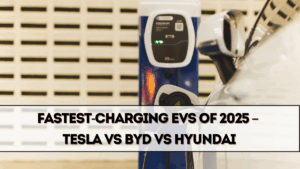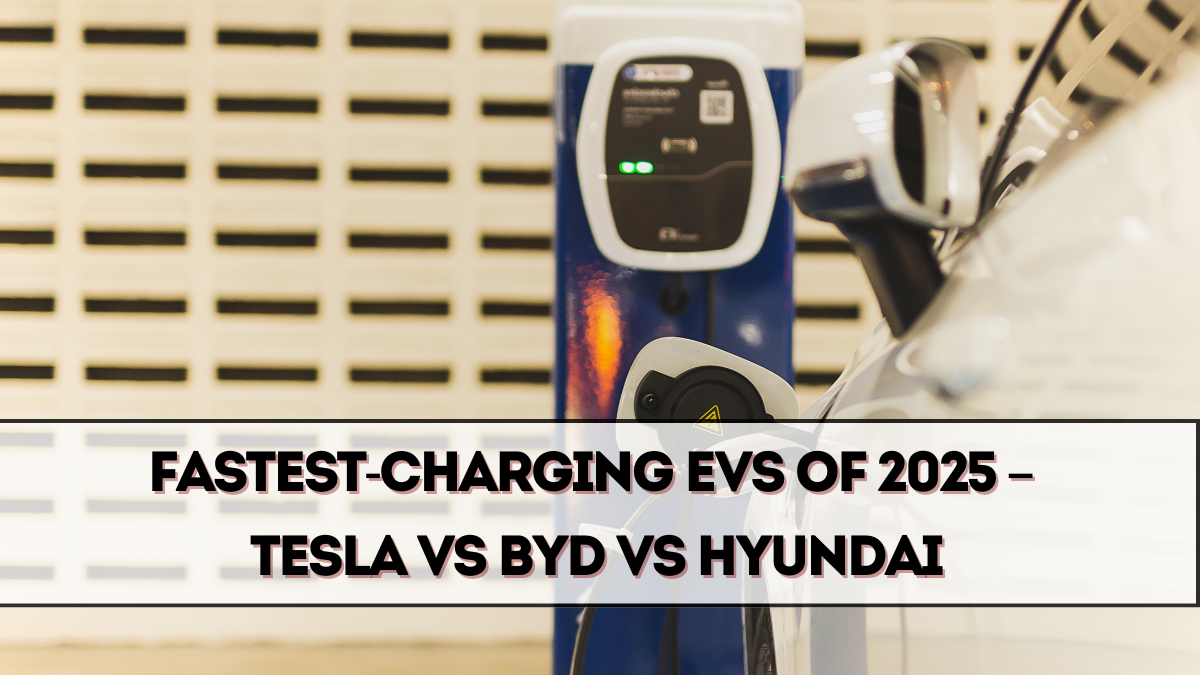One of the biggest concerns for electric vehicle (EV) owners has always been charging time. In 2025, EV manufacturers are racing not only to extend range but also to reduce the time it takes to recharge. The latest models from Tesla, BYD, Hyundai, and other automakers promise faster charging speeds, giving drivers confidence for both daily commutes and long road trips. This detailed EV Charging Time Comparison 2025 examines the fastest-charging EVs, the technology behind them, and what drivers can expect in real-world use.

Why Charging Speed Matters in 2025
As EV adoption accelerates, charging speed has become as important as range. Drivers demand shorter wait times, especially when traveling. The following reasons explain why this year’s charging updates are crucial:
-
Convenience: Faster charging makes EVs more practical for everyday life.
-
Long-Distance Travel: Shorter charging stops make road trips easier.
-
Competition with Petrol Cars: Quicker charging reduces the gap with refueling times.
-
Energy Efficiency: New charging technologies minimize heat loss and improve battery health.
With global networks expanding, charging speed is no longer just a feature; it’s a core part of EV buying decisions.
Top EV Brands Compared
In 2025, three brands dominate the conversation: Tesla, BYD, and Hyundai. Each has introduced upgraded battery packs and charging technology.
-
Tesla
-
Uses Supercharger V4 stations offering up to 350 kW charging.
-
Model 3 and Model Y can charge from 10% to 80% in around 18–20 minutes.
-
Larger models like the Model S Plaid achieve similar performance thanks to optimized battery cooling systems.
-
-
BYD
-
Known for its Blade Battery technology, which supports ultra-fast charging.
-
The BYD Seal and Atto 4 can charge 10% to 80% in about 22–25 minutes.
-
Offers good efficiency, especially in urban driving cycles.
-
-
Hyundai (IONIQ series)
-
Hyundai’s 800V architecture remains one of the fastest in the industry.
-
The IONIQ 5 and IONIQ 6 can charge from 10% to 80% in just 17–18 minutes at a 350 kW DC charger.
-
Consistently praised for maintaining battery health even under frequent fast charging.
-
Other players like Kia EV6, Mercedes EQS, and Porsche Taycan also perform well, but Tesla, BYD, and Hyundai stand out due to their global accessibility and reliability.
Charging Speed Table 2025
Here’s a quick comparison of charging times for popular EVs:
| Brand & Model | Battery Size | Charging Time (10–80%) | Charging Power |
|---|---|---|---|
| Tesla Model 3 (2025) | 75 kWh | 18–20 minutes | 350 kW V4 |
| Hyundai IONIQ 6 | 77 kWh | 17–18 minutes | 350 kW (800V) |
| BYD Seal | 82 kWh | 22–25 minutes | 300 kW |
| Kia EV6 | 77.4 kWh | 18–20 minutes | 350 kW |
| Porsche Taycan 2025 | 93 kWh | 20–22 minutes | 350 kW |
This table shows that Hyundai leads marginally, but Tesla and Kia are close behind, while BYD offers an excellent balance of cost and speed.
Real-World Factors Affecting Charging
While brochures highlight ideal charging times, real-world conditions can vary. Factors that affect EV charging include:
-
Charger Availability: High-speed 350 kW stations are still limited in some areas.
-
Battery Temperature: Cold weather slows charging unless pre-conditioning is used.
-
Charger Load: Shared stations may reduce available power.
-
Battery Age: Older batteries may not charge as quickly.
Thus, while official numbers suggest sub-20-minute charging, drivers should expect around 20–30 minutes in practical use.
The Role of Charging Networks
Faster cars require faster networks. In 2025:
-
Tesla’s Supercharger V4 is being rolled out across Europe, North America, and parts of Asia.
-
Ionity and Electrify America continue expanding with 350 kW charging.
-
BP Pulse and Shell Recharge are upgrading to ultra-rapid stations in the UK and Australia.
-
BYD and local networks in China and Southeast Asia are building dense charging infrastructure.
This global expansion ensures that charging times promised on paper are achievable on the road.
How EVs Compete Against Petrol in 2025
Petrol cars still take just a few minutes to refuel, but EVs are closing the gap. In 2025:
-
Charging from 10% to 80% takes under 20 minutes for leading models.
-
Average savings on fuel costs remain 40–60% compared to petrol cars.
-
Eco-conscious buyers see fast charging as an added advantage, not just a convenience.
This means EVs are no longer just an eco-friendly option but a practical mainstream choice.
Future of Charging Speeds
By 2030, charging may get even faster. Automakers are already testing:
-
1,000V architectures capable of charging in under 10 minutes.
-
Solid-state batteries that allow higher energy density and faster charging.
-
Smart Charging Integration with home energy systems and renewable sources.
-
Wireless Charging Pads for hands-free convenience.
The EV Charging Time Comparison 2025 shows that what once took hours can now be done in minutes, and the future promises even more improvements.
FAQs
Which EV has the fastest charging in 2025?
The Hyundai IONIQ 6 leads slightly, charging from 10% to 80% in about 17–18 minutes.
How fast does Tesla charge in 2025?
With Supercharger V4, Tesla models like the Model 3 can charge in around 18–20 minutes.
Does BYD offer fast charging compared to Tesla and Hyundai?
Yes, BYD models like the Seal charge in 22–25 minutes, slightly slower but still competitive.
Do weather conditions affect charging times?
Yes, cold or hot temperatures can impact battery performance and extend charging times.
Click here to know more.
